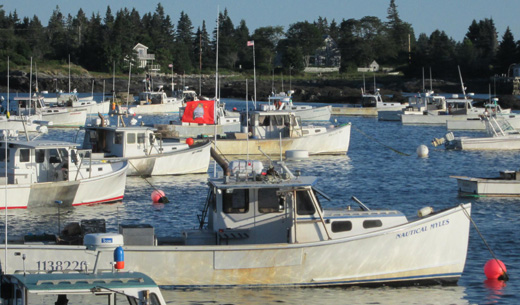
VINALHAVEN, Maine — Hauling and tending traps, harvesting lobsters, baiting and setting back the traps, one string at a time with five to 15 traps per string, is the routine of fishermen who work on deck of lobster boats up and down the Gulf Coast
The sequence is repeated again and again and again, all in a day’s work hauling 300 traps/day. There are some 6,000-plus such workers in Maine that best fit Victor Hugo’s general description of them more than a century ago – toilers of the sea.
Yet a recent editor’s note in Down East Magazine made them vanish from sight.
Incredibly, those servant scribes of big business stated boldly that lobstering was not an important industry in the state of Maine. The magazine did this by writing that there were only 4,600 licensed lobstermen in Maine. These are the owners of the boats, who usually skipper them. In making this claim, the editor’s note made the workers at the other end of the boats, the stern, who haul those lobsters from the bottom of the ocean, literally disappear.
Why would the editors do this when in the same magazine they extol the lobster industry?
A titanic struggle over who owns those same lobsters tells the tale. It is between those who actually do the work and those who own the processing plants. One need not look far to see where the interests of the magazine lie. A glance at the full-page ads representing the lobster processors tells the tale quite plainly.
This struggle has become so intense that lobster workers are doing what they haven’t attempted in over 100 years: organize a lobster workers union.
Organizing a lobster union started in 1905 out of the Island community of Vinalhaven, in Maine’s Penobscot Bay. Granite workers who had union experience helped in the effort. By 1907 there were 1,055 members in 22 locals up and down the coast of Maine.
Unfortunately a depression hit in 1907 causing petty competition. By 1909, there were only four locals left. Other reasons given for the union’s demise were lack of patience, unrealistic demands and an inability to accept leadership.
What has changed since the early 20th century? The control of the lobster industry is much more concentrated in fewer hands. A key player comes from a family with a name well known to Mainers and those who visit by the tens of thousands each year: L.L. Bean.
It was Linda Bean who recognized that the lobster industry, in big business speak, was undervalued. Translation – more profits could be squeezed out of the workers who actually do the work. How do the processors do this? By introducing mechanization and keeping the price per pound low for lobstermen and high at the retail end.
The tethering of the fishermen and fisherwomen to Bean’s operation is done via the acquisition of bait. The price of bait is withheld from payment for each pound delivered during fishing season, in “company store” fashion. Bait then is made available in the ensuing year.
Previously, the penalty for not working with Bean the following year was forfeiture of that bait money. This penalty has been removed, in part, due to the recent organizing efforts of the fishermen.
The triple killers of capitalism are at work in Maine with lobster workers and their families squarely in its sights.
The rapaciousness of the market and the assault on the environment are intertwined. Overzealous fishing of bait fish such as herring has had numerous consequences. They are gone from Penobscot Bay. Bait must be secured from faraway sources such as the Socialist Republic of Vietnam and New Zealand. This has raised the price of bait and added a considerable carbon footprint to the industry.
Market demand also led to overfishing of other oceanic species such as cod. Those species are essentially gone. The absence of these predators has led to an explosion of the lobster population.
This environment has left lobsters the main viable source of income for those who fish for a living here. This in turn leaves the lobstermen and women no choice. Due to the low wholesale price, they must haul more lobsters to make a living. In other words, work harder and longer.
The environmental consequences of all this are both obvious and ominous. This monoculture environment is rife for disease. There is little balance in the ecosystem to weather a disease episode.
Global climate change is affecting the shellfish industry. The National Marine Fisheries Service, since the 1960s, procured data on invertebrate – such as lobster – migrations. Their data show the waters off the continental shelf, Georges Bank and the gulf of Maine have been warming.
Scientists Malin Pinsky and Michael Fogarty track the repercussions of these warming waters on lobsters. They found that lobsters (Homarus americanus) have been migrating to higher latitudes and deeper, cooler waters. This is the more immediate threat to the lobstermen and women as fuel costs and danger accompany the shift to deeper waters further from the coast.
Also, the record catch of lobsters, in 2012 reaching 135 million pounds in Maine, may have unknown consequences for the future as the lobster boats venture further and further out for their catch.
Lastly, with concentration of power in fewer and fewer hands, processors like Linda Bean are lining their pockets with more profits leaving less for the lobstermen and women who actually do the work.
Lobster fishing is crucial to coastal Maine and its island communities. It is no wonder that union organizing and defending the environment are on the uptick among these toilers of the sea.
Photo: Union flags of the International Association Of Machinists Lobster Union (IAMLU) now grace boats in Carver’s Harbor, Vinalhaven, Maine. PW












Comments